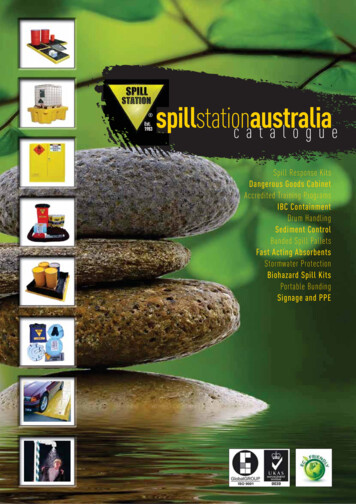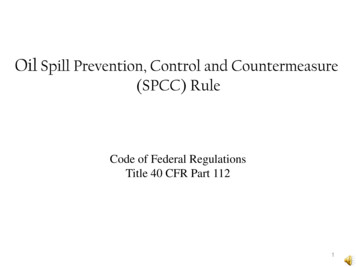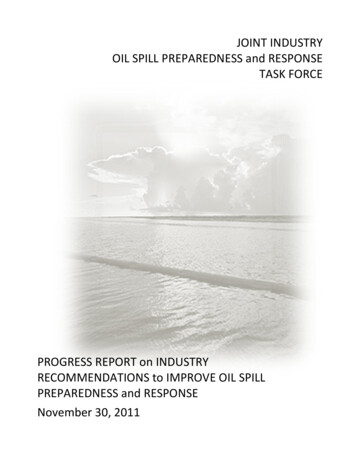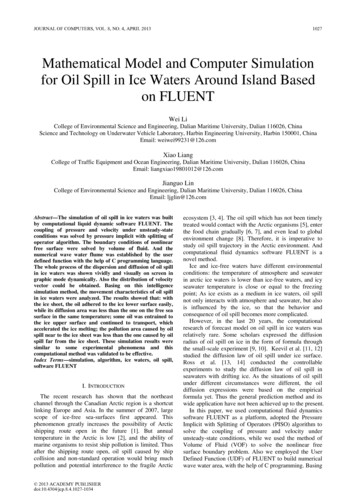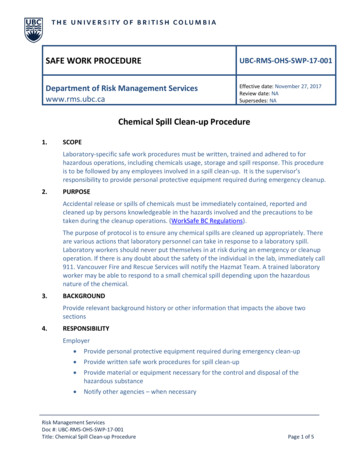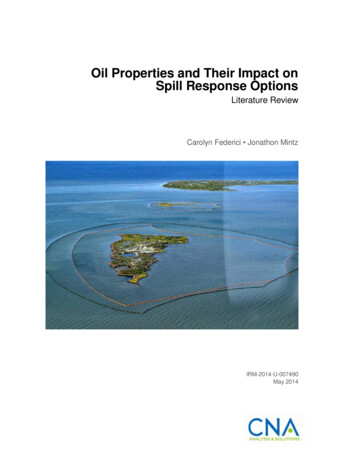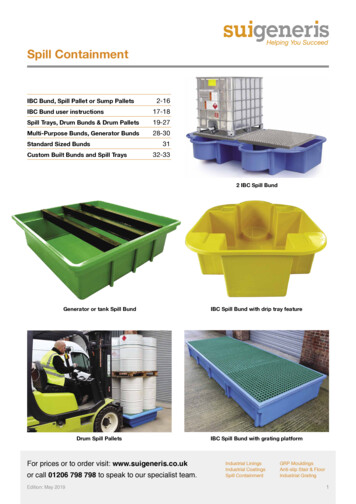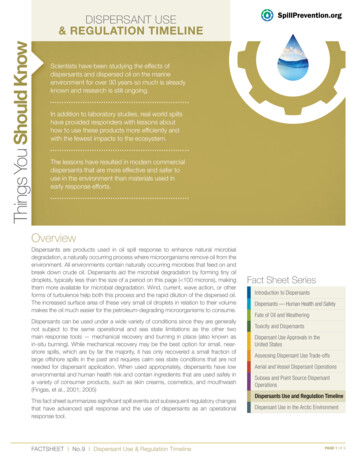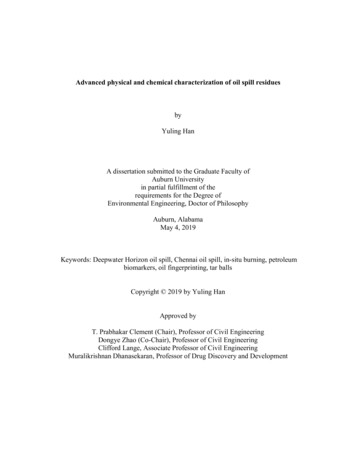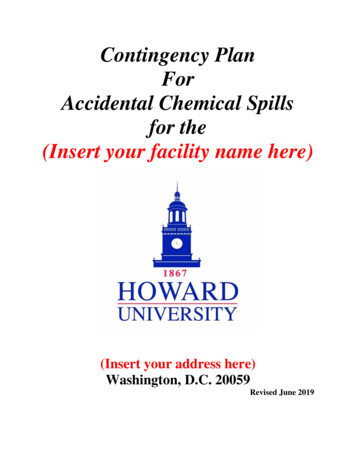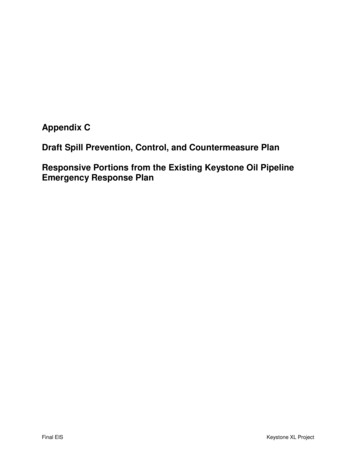
Transcription
Appendix CDraft Spill Prevention, Control, and Countermeasure PlanResponsive Portions from the Existing Keystone Oil PipelineEmergency Response PlanFinal EISKeystone XL Project
Keystone XL Pipeline ProjectSpill Prevention, Control and Countermeasure PlanDRAFTSubject to ChangeNote: This document is a template for the Project’s Spill Prevention, Control and CountermeasurePlans and will be finalized by each contractor based on all required site-specific information.
Table of Contents1Introduction . 11.1Scope . 12Contractor Supplied Site-Specific Information. 13Prevention. 23.1Training . 23.2Site Security . 33.3Equipment Inspection and Maintenance. 33.4Materials Storage and Handling. 43.4.1Tanks . 43.4.2Containers. 53.4.3Concrete Coating . 63.4.4Disposal of Solid and Hazardous Wastes. 63.4.5Equipment Refueling and Servicing. 63.4.6Spill Response Equipment. 73.4.7Activities in Environmentally Sensitive Areas . 84Spill Control and Countermeasures . 85Documentation and Reporting . 86Inspection and Record Keeping . 97Applicable State Requirements . 98Certification of Non-Substantial Harm. 10Attachment AAttachment BAttachment CAttachment DAttachment EAttachment FAttachment GAttachment HAttachment IAttachment JAttachment KAttachment LAttachment MSPCC Cross Reference TableContractor Yard or Fueling Station Facility DiagramHazardous Materials Inventory and Reportable QuantitiesContractor’s Training ProgramEmergency Response ContactsContractor’s Emergency Response ProceduresContractor’s CommitmentsProfessional Engineer’s CertificationState RequirementsContractor’s Material Safety Data Sheets (MSDS)Typical Layouts; Fuel Transfer StationsSpill Report FormCertification of the Applicability of the Substantial Harm CriteriaKeystone Spill Prevention, Control and Countermeasure Plani
1 IntroductionThe purpose of this Spill Prevention, Control and Countermeasure (SPCC) Plan is to establishprocedures to prevent the discharge of hazardous or regulated materials during construction ofthe Keystone XL Pipeline Project (Project), particularly into or upon Waters of the U.S. The SPCCPlan is designed to reduce the likelihood of a spill, provide for prompt identification and properremoval of contaminated materials if a spill does occur, comply with applicable state and federallaws (e.g., Title 40 Code of Federal Regulations [CFR] Parts 112 and 122) and Project permits,and to protect human health and the environment. The SPCC Plan is designed to complementexisting laws, regulations, rules, standards, policies and procedures pertaining to safetystandards and pollution rules, in order to minimize the potential for unauthorized releases ofhazardous materials, fuels and lubricants.TransCanada Keystone Pipeline, L.P. (Keystone) anticipates that the Project Pipelineconstruction contactor (Contractor) will store or handle more than the threshold quantities of oilproducts and will therefore be subject to federal SPCC preparation requirements. In conformancewith federal regulations, a cross-reference table is provided in Attachment A that lists therelevant sections in Title 40 CFR 112.7 and the equivalent sections in this SPCC Plan.Amendments to the SPCC Plan will be made as necessary during construction to account forincreases in the volumes of materials stored or other changes associated with the handling orstorage of hazardous materials.1.1 ScopeThis SPCC Plan applies to all construction and reclamation activities on the Project, but does notcover pipeline or pump station operations or maintenance. The Keystone XL Project EmergencyResponse Plan will contain the SPCC requirements for operation and maintenance of the pipelineand pump stations.This plan outlines the procedures for prevention, containment, and control of potential spillsduring Project construction and reclamation. The SPCC Plan applies to the use of hazardousmaterials on the right-of-way and all ancillary facilities. This includes the refueling or servicing ofall equipment with diesel fuel, gasoline, lubricating oils, grease, hydraulic and other fluids duringnormal upland work and for special applications located within 100 feet of streams and wetlands.In addition, site-specific information to be provided by the Contractor is identified and will beattached to the document.This document is not a complete summary of all requirements. The Contractor is responsible forthoroughly researching, understanding, and complying with all applicable federal, state, and localrequirements related to all aspects of work on the Project, including polluting, toxic, andhazardous materials handling, storage, transportation, spill prevention, clean-up and disposal,documentation, notification, hazardous waste, and training.2 Contractor Supplied Site-Specific InformationThis document is a template for the Project’s SPCC Plans and will be finalized by each contractorbased on all required site-specific information.The following information must be supplied by the Contractor for review and approval byKeystone at least 30 days prior to construction activities. Contractor yard or fueling station facility diagram (Attachment B) showing at a minimumthe following:o storage tanks, including content and capacity;Keystone XL Spill Prevention, Control and Countermeasure PlanSPCC-1
ooooooooooo mobile portable containers that store 55 gallons or more (including contents andcapacity);oil-filled equipment, electrical transformers, circuit breakers, etc. that store 55gallons or more;any other oil-filled equipment (including content and capacity);oil/fuel transfer area;secondary containment structures;storm drain inlets and surface waters that could be affected by a discharge;direction of flow in the event of a discharge (topography) and potential receivingwaters;legend that indicates scale and identifies symbols used in the diagram;location of response kits and firefighting equipment;location of valves or drainage system control that could be used in the event of adischarge to contain materials on the site; andcompass direction.A complete inventory of all hazardous materials that will be used or stored on site,including reportable quantities in compliance with state and federal law (Attachment C);Contractor’s training program for fuel truck drivers and mechanics (See Attachment Dand Section 3,1 Training section below for details);Designation of the Contractor’s Spill Response Coordinator (to be included inAttachment E Emergency Response Contacts);Emergency response procedures (Attachment F), as described in the ConstructionMitigation and Reclamation Plan. In addition, the Contractor will include a prediction ofthe direction, rate of flow, and total quantity of oil/fuel which has the reasonable potentialto be discharged, based on experience. A form has been provided in Attachment F;Contractor’s Commitment to providing the necessary emergency response support forthe Project (Attachment G);Certification by a registered Professional Engineer (Attachment H);A complete discussion of applicable state-specific requirements regarding oil product andhazardous materials handling that are stricter than the federal requirements (to beincluded in Attachment I State Requirements), if any. If none, then the Contractor willclearly state that in the discussion;Material Safety Data Sheets (MSDS) as supplied by the Contractor (Attachment J); andAny mutual aid agreements between the Contractor and other emergency responsepersonnel.The Contractor is encouraged to use the Environmental Protection Agency’s (EPA) guidancedocument for preparing facility diagrams provided at the following website:www.epa.gov/oilspill/pdfs/guidance/6 FacilityDiagrams.pdf.Amendments to the Contractor-Supplied SPCC Plan will be made as necessary duringconstruction to account for increases in the volumes of materials stored or other changesassociated with the handling or storage of hazardous materials.3 PreventionKeystone’s goal is to prevent spills or exposure to hazardous or dangerous substances duringconstruction of the Project. The Contractor is required to follow the prevention measures outlinedbelow and implement other measures as necessary and required to promote spill prevention.3.1 TrainingPersonnel accountable for carrying out the procedures specified in this plan will be designatedbefore construction and informed of their specific duties and responsibilities with respect toenvironmental compliance and hazardous materials. The Contractor will be required to provideKeystone XL Spill Prevention, Control and Countermeasure PlanSPCC-2
additional spill prevention, response and hazardous materials handling training to all of their staffwho handle hazardous materials, fuels and lubricants on a regular basis. The Contractor willprovide the details of this training to Keystone prior to the start of work (Attachment D). At aminimum, training will include: A review of this SPCC Plan;An overview of all regulatory requirements;Waste minimization practices;Proper storage and handling methods for hazardous materials, fuels, lubricants, gases,etc.;Spill prevention, clean-up, and reporting requirements;Proper disposal techniques for hazardous materials, fuels, lubricants, etc.;Proper procedures for transferring fuels and containing fluids while doing maintenance onvehicles;Special requirements for refueling within 100 feet of wetlands and waterbodies;The location of the MSDSs and the SPCC Plan;The proper use of personal protective equipment;Emergency and spill response material locations, proper use, and maintenance;Emergency contact information and notification procedures; andProcedures for documenting spills and standard spill information to be provided toKeystone for agency notification.All personnel working on the Project, including all Contractor personnel, are required to attend aProject-sponsored training session prior to starting work. Keystone will conduct training to ensureall responsible Contractor employees know of and comply with all project-specific environmentaland TransCanada environmental policy requirements. The environmental training program willaddress refueling restrictions, hazardous materials handling, spill prevention and cleanuprequirements, as well as other Project environmental and safety topics.3.2 Site SecurityThe Contractor’s site-specific plan and documentation for the construction yard will address sitesecurity procedures. Bulk fuel storage areas (including valves and switches), fuel trucks,lubricants and hazardous materials will be secured to minimize tampering and accidentalreleases by unauthorized personnel. Site security will include the following, in compliance with40 CFR 112.7(g): The oil/fuel storage site will be fully fenced with a locked or guarded entrance gate whenfacility is unattended;Container master flow and drain valves will be secured so that they will remain in theclosed position when not in use;Fuel pump starter controls will be locked in the “off” position where only authorizedpersonnel can access them when not in use; andFacility lighting at night that will assist leak detection and vandalism prevention.If the above procedures will not be followed, the Contractor will provide a detailed explanation ofwhy the site cannot be secured as described above and the equivalent method the Contractor willuse to secure the site.All storage containers will be closed when not in use and the storage areas will be secured(gated, locked and/or guarded) at night and/or during non-construction periods.3.3 Equipment Inspection and MaintenanceThe Contractor will ensure that all equipment is free of leaks prior to use on the Project, and priorto entering or working in or near waterbodies or wetlands. Throughout construction, theKeystone XL Spill Prevention, Control and Countermeasure PlanSPCC-3
Contractor will conduct regular maintenance and inspections of the equipment to reduce thepotential for spills or leaks.Contractor mechanics will assess the general condition of equipment valves, lines and hoses andall deteriorated parts will be promptly repaired or replaced. Vehicles and equipment that developleaks during construction activities will cease work, move to a location at least 100 feet fromstreams or wetlands, and buckets or absorbent materials will be placed under the equipment untilthe leak can be repaired. Soils contaminated by the leaking material will be collected andremoved from the right-of-way for proper disposal. Equipment that requires extensive repairs willbe removed from the right-of-way until the repairs are completed or a protection plan will bedeveloped by the Keystone Environmental Inspector if the equipment can not be moved.All equipment maintenance and repairs will be performed in upland locations at least 100 feetfrom waterbodies and wetlands. Mechanics will take precautionary measures when performingequipment maintenance or repair activities by placing absorbent pads (or equivalent materials) onthe ground beneath the equipment when changing crankcase oil, repairing hydraulic lines, oradding coolant to construction equipment and when appropriate for other repair activities.All equipment parked overnight shall be at least 100 feet from a watercourse or wetland, ifpossible. Equipment shall not be washed in streams or wetlands.3.4 Materials Storage and HandlingThe Contractor shall ensure that all oil products, fuels, gases, hazardous and potentiallyhazardous materials are transported, stored and handled in accordance with all applicablelegislation.Staging areas (including contractor yards and pipe yards) will be set up for each constructionspread. Contractors conducting work in each of these areas will establish bulk fuel storage tankswithin the staging area, or they will fill their fuel trucks at existing bulk fuel dealerships. In addition,a variety of lubricants and materials will be stockpiled at the staging area for use duringconstruction of the Project. Bulk fuel storage tanks, fuel trucks and stockpiles of lubricants orhazardous materials will be stored only in the designated staging areas and equipment storageyards, and at least 100 feet from all streams and wetlands. No hazardous materials will be storedin areas subject to flooding or inundation.Spent oils, lubricants, filters, etc. shall be collected and disposed of or recycled at an approvedlocation in accordance with state and federal regulations.Keystone contractors will not keep on site or operate the following: Completely or partially buried storage tanksBuried pipingInternal steam heat coilsLarge, field-erected storage tanksThe following sections detail Project requirements associated with storage of bulk fuels andlubricants, as well as temporary storage of hazardous materials at staging areas.3.4.1 TanksKeystone contractors will maintain commonly used fuels such as gasoline and diesel in bulkstorage tanks in the pipeline contractor yards. All storage tanks or trailers, rigid steel piping,valves and fittings and fuel transfer or dispensing pumps will be contained within a secondarycontainment structure providing 110 percent containment volume of the largest storage tank ortrailer within the containment structure. This containment structure will consist of sandbag orearth berms lined with a chemical resistant membrane liner or a concrete structure. TheKeystone XL Spill Prevention, Control and Countermeasure PlanSPCC-4
Contractor will remove any collected precipitation from the containment structure to maintain 110percent capacity. The Contractor will inspect accumulated precipitation first for evidence of oil orcontamination and then collect the material for proper disposal off-site.The attached drawings are typical layouts for diesel and gasoline fuel transfer stations. Selfsupporting tanks will be constructed of carbon steel or other materials compatible with contents ofeach tank, and all tanks will be elevated above grade and inspected weekly and when the tank isrefilled. To prevent overfill, all tanks will have visual level gauges and actual tank levels will bechecked against the gauge reading during inspections. Inspection records shall be maintained bythe Contractor.For receiving and offloading fuels from a fuel distributor into the bulk storage tanks, the distributorwill connect a petroleum rated hose from the delivery tanker to the fuel transfer stations fill line atthe fill truck connection. The fill truck connection and fill line will consist of a cam-loc connectionfollowed by a block valve, rigid steel piping, tank block valve(s) and check valve(s) just upstreamof the connection to the tank. Off-loading of fuel is normally accomplished by a transfer pumppowered by the delivery vehicle’s power take off. Proper grounding of equipment shall beundertaken during fuel transfer operations. Fuel trucks from fuel distributors will be inspectedclosely prior to leaving the contractor yard to ensure that all valves are tightly closed and no leaksoccur during transit.For transfer of fuels from the bulk storage tanks in the contractor yards to fuel distribution trucks,the truck will connect a petroleum rated hose between the truck’s tank and the bulk storage tank’swithdrawal connection. The withdrawal truck connection and withdrawal line will consist of rigidsteel piping from the tank, through a block valve(s) to an electric explosion-proof fuel transferpump. Downstream of the fuel transfer pump will be a cam-loc connection. The fuel transfer pumpwill be equipped with an emergency shut-off at the pump and a secondary emergency shut-off atleast 100 feet away. Proper grounding of equipment shall be undertaken during fuel transferoperations. Fuel truck drivers will inspect the truck after each re-filling from the bulk fuel tanks inthe contractor yard to ensure that all valves are tightly closed and no leaks occur during transport.For dispensing gasoline and on-road diesel to equipment or vehicles, the transfer pump will be adispensing pump with petroleum rated hoses with automatic shut-off nozzles. Refuelingoperations will be attended closely at all times by personnel familiar with the operation of therefueling equipment. Warning signs requiring drivers to set brakes and chock wheels shall bedisplayed at all fixed refueling points. Proper grounding of equipment shall be undertaken duringfuel transfer operations.3.4.2 ContainersAll containers 55 gallons or greater shall be stored on pallets within a secondary temporarycontainment structure. Secondary containment structures may consist of temporary earthenberms with a chemical resistant liner or a portable containment system constructed of steel, PVC,or other suitable material. The secondary containment structure will be capable of containing 110percent of the volume of material stored in these areas. The Contractor will inspect all containerstorage areas for leaks and deterioration at least weekly, and leaking or deteriorated containerswill be replaced as soon as the condition is first detected. In the event of a leak or deterioration ofthe container or liner, cleanup measures would be implemented to remediate all contamination.No incompatible materials will be stored in the same containment area and the containers mustbe suitable and compatible with the wastes or materials in them. If a container leaks or sustainsdamage, its contents must be transferred to a container in good condition. Waste and hazardousmaterials will be kept in separate containers for proper disposal.Containers holding hazardous substances will be closed during transport and storage, except asnecessary to add or remove the substance.Keystone XL Spill Prevention, Control and Countermeasure PlanSPCC-5
3.4.2.1 Container Labeling RequirementsThe Contractor will comply with labeling requirements for any on-site containers, including tanksthat store fuels, lubricants, accumulated hazardous wastes and other materials. Hazardous wastecontainers will be labeled, as required in Title 40 CFR Part 262, and will display at least thefollowing: Chemical name (e.g., oil, diesel, etc.);When the container reaches 55 gallons in volume, the accumulation start date and/or thestart date of the 90-day storage period; andThe words “Hazardous Waste” and warning words specifying the relevant hazards, suchas “flammable”, “corrosive”, or “reactive”.3.4.3 Concrete CoatingConcrete coating and any washout necessary will be conducted at least 100 feet from wetlandsor waterbodies boundaries whenever possible. In some circumstances, it may not be possible tomaintain this buffer due to topography or the extent of the resource. If it is necessary to applyconcrete coating less than 100 feet from a wetland or waterbody boundary, then sufficientcontainment (such as plastic sheeting and berms, etc.) will be provided by the Contractor toprevent any uncured concrete or concrete washout from reaching the ground. Excess concreteshall not be disposed of in wetlands or waterbodies. Concrete washout shall be contained withinthe work area and will not be allowed to enter wetlands, waterbodies, or storm drains.3.4.4 Disposal of Solid and Hazardous WastesThe Contractor will be responsible for ensuring that the regular collection and disposal of all solidand hazardous wastes generated during its operations is in compliance with all applicable laws. Ifstate laws pertaining to waste disposal are more stringent than federal laws, state laws will takeprecedence. The Contractor will determine the details on the proper handling and disposal ofhazardous waste, and will assign responsibility to specific individuals before construction.All hazardous wastes being transported off-site shall be manifested. The manifest shall conformto requirements of the appropriate state agency. The transporter shall be licensed and certified tohandle hazardous wastes on the public highways. The vehicles as well as the drivers mustconform to all applicable vehicle codes for transporting hazardous wastes. The manifest shallconform to regulations of the Department of Transportation Title 49 CFR 172.101, 172.202, and172.203.Hazardous wastes will typically include contaminated soils, spent batteries, and other items. TheContractor will make every effort to minimize hazardous waste production during the Project,including, but not limited to: Minimizing the amount of hazardous materials needed for the Project;Using alternative non-hazardous substances when available; andRecycling usable materials, such as batteries, to the extent possible.3.4.5 Equipment Refueling and ServicingAll equipment refueling will be performed in upland areas at least 100 feet from all wetlands andwaterbodies, and at least 150 feet from private and public water wells, respectively. If site-specificconstraints require refueling/servicing the equipment closer than 100 feet from the wetland orwaterbody, special precautions may be implemented with the Environmental Inspector’s approval– as described below.At all refueling locations along the right-of-way, the Contractor will ensure that absorbentmaterials are on hand at all times. Each refueling vehicle shall have a sufficient number ofKeystone XL Spill Prevention, Control and Countermeasure PlanSPCC-6
shovels, brooms, 10-mil polyethylene sheeting, and fire protection equipment to contain amoderate spill.During refueling, the Contractor will take appropriate measures to reduce the risk of a spill,including not overfilling fuel tanks and placing an absorbent pad under the fuel nozzle whilefueling equipment. Contractor personnel will observe and control refueling at all times to preventoverfilling. Drivers of tank trucks are responsible for safety and spill prevention. Procedures forloading and unloading tank trucks shall meet the minimum requirements established by theDepartment of Transportation.3.4.6 Spill Response EquipmentThe Contractor will be required to have emergency response equipment available at all areaswhere hazardous materials are handled or stored. This equipment shall be readily available torespond to a hazardous material emergency. The Contractor is required to have the appropriatespill response materials on site to address spills of materials stored or handled at the location.Such equipment shall include, but not be limited to, the following: First aid kits and supplies, sized to meet the needs of the numbers of personnelanticipated;Telephone or communications radio;Personal protective equipment (Tyvek or equivalent suits, gloves, goggles, hard hat,and other personal protective equipment appropriate to the materials to be handled);Fire extinguishers;Absorbent materials;Storage containers;Non-sparking bung wrench; andShovels.Hazardous material emergency containment and clean-up materials and equipment shall becarried in all fuel trucks, mechanic and supervisor (foremen) vehicles. This equipment shallinclude, at a minimum: 2 shovels;First aid kit and supplies;Telephone or communications radio;Phone numbers for emergency contacts;2 sets of protective clothing (Tyvek or equivalent suit, gloves, goggles, boots);6 heavy duty plastic garbage bags (30 gallon);5 absorbent socks;10 spill pads;20 lb. fire extinguisher;Barrier tape;2 orange reflector cones; and200 square feet 10-mil plastic sheeting.Fuel and service trucks shall also carry a minimum of 20 pounds of suitable commercial sorbentmaterial and a catch-pan for fluids.Each construction crew, including clean-up crews shall have on hand sufficient tools andmaterials to stop leaks and supplies of absorbent and barrier materials to allow rapid containmentand recovery of spilled materials.Keystone XL Spill Prevention, Control and Countermeasure PlanSPCC-7
The Contractor shall inspect emergency equipment weekly, and service and maintain equipmentregularly, replenishing supplies as necessary. Records shall be kept of all inspections andservice.3.4.7 Activities in Environmentally Sensitive AreasThe Contractor will obtain approval from the Keystone Environmental Inspector prior to refuelingor performing equipment repair (involving lubricants, fuels, oil products, or hazardous materials)within 100 feet of a wetland or waterbody boundary. The Contractor shall monitor the refuelingand equipment operation at all times. The Contractor will take precautions to prevent spillage bynot overfilling fuel tanks, placing an absorbent pad under the fuel nozzle while fueling, and wipingthe nozzle when fueling is complete.Stationary equipment will be placed within a secondary containment if it will be operated orrequire refueling within 100 feet of a wetland or waterbody boundary.In order to respond quickly to a potential spill in a major waterbody, the Contractor shall have onhand during all river crossings at least 400 feet of sorbent boom/sock and provide in AttachmentF a method for deployment and collection.4 Spill Control and CountermeasuresIt is Keystone’s goal to promptly stop spills, however the safety and health of Project personneland the public is the foremost priority. Personnel should only respond to a spill if they haveadequate training to do so safely.All spills and leaks of hazardous materials and petroleum products will be cleaned up. Upondiscovery of a spill, the Contractor will immediately:1. Assess the area for safety: identify the material spilled, the cause, and any potentialhazards. If it is an emergency threatening human health, dial 911. If telephone service isnot available or 911 does not work in the area, immediately contact the spread office soemergency responders can be notified. Implement appropriate safety procedures, basedon the nature of the hazard.2. Extinguish or remove ignition sources, if the spilled material is flammable.3. Shut off leaking equipment, if safe to do so.4. Stop leaks, if possible.5. Contain the spill using spill response materials and by creating a berm or dike, ifnecessary. Block culverts, storm sewers, and other points, if necessary to limit spill travel.6. Notify supervisor of the spill, including material, quantity, time, and location. Supervisorsare responsible for notifying Keystone of
Plan is designed to reduce the likelihood of a spill, provide for prompt identification and proper removal of contaminated materials if a spill does occur, comply with applicable state and federal laws (e.g., Title 40 Code of Federal Regulations [CFR] Parts 112 and 122) and Project permits, and to protect human health and the environment.
